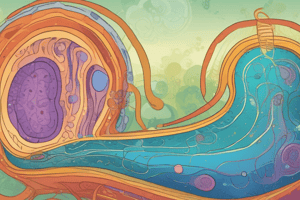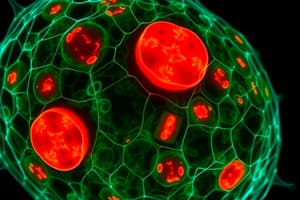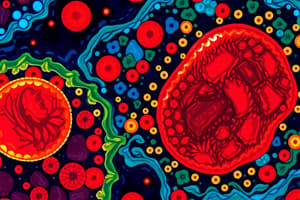Podcast
Questions and Answers
What process do mitochondria primarily use to convert energy derived from carbohydrates and fatty acids into ATP?
What process do mitochondria primarily use to convert energy derived from carbohydrates and fatty acids into ATP?
- Oxidative phosphorylation (correct)
- Beta-oxidation
- Fermentation
- Glycolysis
Which of the following statements about mitochondrial proteins is true?
Which of the following statements about mitochondrial proteins is true?
- All mitochondrial proteins are synthesized within the mitochondria.
- Mitochondrial proteins are synthesized on the ribosomes attached to the mitochondrial membrane.
- Most mitochondrial proteins are encoded by the nuclear genome. (correct)
- Mitochondrial proteins are imported as incomplete polypeptides.
What is the main function of peroxisomes in the cell?
What is the main function of peroxisomes in the cell?
- Breakdown of fatty acids and detoxification (correct)
- ATP production
- Synthesis of ribosomal RNA
- Storage of genetic information
What structural feature of mitochondria increases their surface area?
What structural feature of mitochondria increases their surface area?
Which type of genetic material is found within mitochondria?
Which type of genetic material is found within mitochondria?
Which of the following best describes how proteins are directed to mitochondria?
Which of the following best describes how proteins are directed to mitochondria?
What is the main compartment of the mitochondria where oxidative metabolism takes place?
What is the main compartment of the mitochondria where oxidative metabolism takes place?
What characteristic of mitochondria contributes to their dynamic nature?
What characteristic of mitochondria contributes to their dynamic nature?
What is the role of mobile chaperones Tim9-Tim10 in mitochondrial protein transport?
What is the role of mobile chaperones Tim9-Tim10 in mitochondrial protein transport?
Which complex is responsible for the insertion of outer membrane proteins into the mitochondria?
Which complex is responsible for the insertion of outer membrane proteins into the mitochondria?
How are multipass transmembrane proteins typically targeted to the inner mitochondrial membrane?
How are multipass transmembrane proteins typically targeted to the inner mitochondrial membrane?
What type of proteins are predominantly found in the outer mitochondrial membrane?
What type of proteins are predominantly found in the outer mitochondrial membrane?
Where are the majority of lipids found in mitochondrial membranes synthesized?
Where are the majority of lipids found in mitochondrial membranes synthesized?
Which process is responsible for synthesizing cardiolipin in mitochondria?
Which process is responsible for synthesizing cardiolipin in mitochondria?
What function do the chaperones serve after proteins exit the Tom complex?
What function do the chaperones serve after proteins exit the Tom complex?
What characteristic do many of the inner membrane proteins that do not contain presequences share?
What characteristic do many of the inner membrane proteins that do not contain presequences share?
What is a potential method to avoid transmitting mitochondrial diseases to offspring?
What is a potential method to avoid transmitting mitochondrial diseases to offspring?
How many proteins are contained within mammalian mitochondria that are encoded by nuclear genes?
How many proteins are contained within mammalian mitochondria that are encoded by nuclear genes?
What is the role of Tom complex in mitochondrial protein transport?
What is the role of Tom complex in mitochondrial protein transport?
Which sequence primarily directs proteins to mitochondrial import?
Which sequence primarily directs proteins to mitochondrial import?
What must proteins do to be directed to the mitochondrial matrix?
What must proteins do to be directed to the mitochondrial matrix?
What is the function of Tim23 in mitochondrial protein transport?
What is the function of Tim23 in mitochondrial protein transport?
What establishes the electrochemical potential that aids in mitochondrial protein transport?
What establishes the electrochemical potential that aids in mitochondrial protein transport?
Which of the following techniques involves manipulation or destruction of embryos?
Which of the following techniques involves manipulation or destruction of embryos?
Flashcards
What is the primary function of mitochondria?
What is the primary function of mitochondria?
Mitochondria are cellular organelles responsible for generating most of the cell's energy via the breakdown of carbohydrates and fats.
Describe the structure of a mitochondrion.
Describe the structure of a mitochondrion.
Mitochondria are surrounded by two membranes: an outer membrane and an inner membrane. The space between these membranes is called the intermembrane space.
What are cristae?
What are cristae?
The inner membrane of mitochondria is folded into cristae, which increase the surface area for energy production.
What is the mitochondrial matrix?
What is the mitochondrial matrix?
Signup and view all the flashcards
What is mitochondrial DNA?
What is mitochondrial DNA?
Signup and view all the flashcards
Where are mitochondrial proteins made?
Where are mitochondrial proteins made?
Signup and view all the flashcards
How do mitochondria adapt to cellular needs?
How do mitochondria adapt to cellular needs?
Signup and view all the flashcards
What is oxidative phosphorylation?
What is oxidative phosphorylation?
Signup and view all the flashcards
What are mitochondrial diseases?
What are mitochondrial diseases?
Signup and view all the flashcards
Is there a cure for mitochondrial disease?
Is there a cure for mitochondrial disease?
Signup and view all the flashcards
How are mitochondrial diseases inherited?
How are mitochondrial diseases inherited?
Signup and view all the flashcards
What is Preimplantation Genetic Diagnosis (PGD)?
What is Preimplantation Genetic Diagnosis (PGD)?
Signup and view all the flashcards
What are Mitochondrial Replacement Techniques (MRT)?
What are Mitochondrial Replacement Techniques (MRT)?
Signup and view all the flashcards
Where are mitochondrial proteins synthesized?
Where are mitochondrial proteins synthesized?
Signup and view all the flashcards
How are proteins imported into mitochondria?
How are proteins imported into mitochondria?
Signup and view all the flashcards
What helps proteins cross the mitochondrial membrane?
What helps proteins cross the mitochondrial membrane?
Signup and view all the flashcards
Mitochondrial Presequence
Mitochondrial Presequence
Signup and view all the flashcards
TOM Complex
TOM Complex
Signup and view all the flashcards
TIM22 Complex
TIM22 Complex
Signup and view all the flashcards
Oxa1 Translocase
Oxa1 Translocase
Signup and view all the flashcards
Tim9-Tim10
Tim9-Tim10
Signup and view all the flashcards
SAM Complex
SAM Complex
Signup and view all the flashcards
Cardiolipin
Cardiolipin
Signup and view all the flashcards
Lipid Import
Lipid Import
Signup and view all the flashcards
Study Notes
Mitochondria
- Mitochondria are responsible for generating most cellular energy from the breakdown of lipids and carbohydrates.
- They are found in all cells.
- Mitochondria have a double membrane structure: an outer and inner membrane.
- The inner membrane folds into cristae, increasing surface area available for chemical reactions.
- The matrix contains the mitochondrial genetic system plus enzymes for key oxidative metabolic reactions.
- The oxidative breakdown of glucose and fatty acids produces ATP.
- Mitochondrial proteins are coded and translated by the nuclear genome, then directed to organelles.
- Mitochondria contain their own DNA (mtDNA) that encodes tRNA, rRNA, and some mitochondrial proteins.
- Mitochondrial membrane structure is maintained by fusion and fission processes.
Peroxisomes
- Peroxisomes are small organelles found in all eukaryotic cells.
- They are surrounded by a membrane.
- These organelles contain enzymes for varied metabolic pathways, including fatty acid breakdown and photorespiration.
- Peroxisomes contain enzymes to produce hydrogen peroxide, which is then broken down by catalase.
- They play a role in the oxidation of fatty acids in the cellular metabolic processes.
- Peroxisomes are involved in lipid synthesis (e.g., plasmalogens)
- Peroxisomes have no genome of their own.
- Peroxisomal proteins are synthesized on cytosolic ribosomes, but some are from the ER.
- Many peroxisomal proteins contain specific targeting signals that allow specific targeting.
- Peroxisomes can form through budding or by division from existing peroxisomes.
Mitochondrial and Peroxisomal Protein Import and Formation
- Proteins destined for mitochondria and peroxisomes are usually synthesized in the cytosol, then imported into their respective target organelles.
- Proteins destined for the mitochondria and peroxisomes are complete polypeptide chains.
- Transport into these organelles is through a series of proteins that form import machinery.
- The inner membrane of mitochondria contains the import machinery (TOM/TIM) to transport proteins inside
Studying That Suits You
Use AI to generate personalized quizzes and flashcards to suit your learning preferences.





